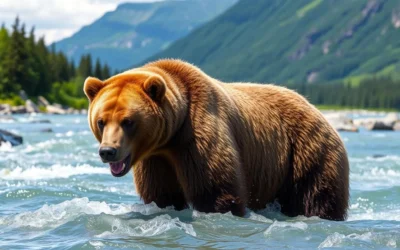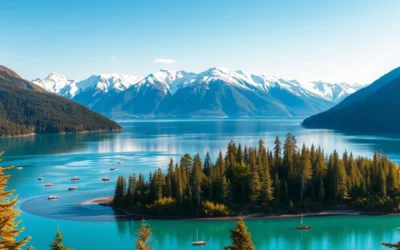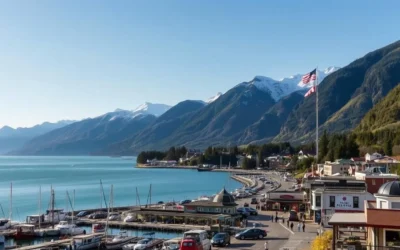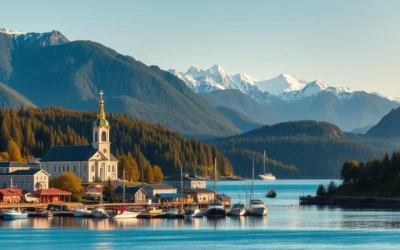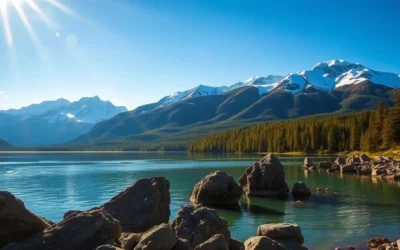✓ Accommodations✓ Flights✓ Rental Cars✓ Tours & Activities
Did you know that Anchorage experiences a subarctic climate, with significant variations in temperature and daylight throughout the year? This unique weather pattern makes planning your trip crucial to enjoying the best of what Alaska has to offer.
Understanding the Anchorage Alaska weather is key to a successful trip. Whether you’re looking for summer adventures or winter landscapes, knowing the best time to visit Anchorage can make all the difference.
This guide will help you navigate the seasonal changes in Anchorage, ensuring you’re prepared for your visit. You’ll learn about temperature ranges, precipitation patterns, and daylight hours, allowing you to plan your trip according to your preferences.
Anchorage’s Climate Overview
Anchorage’s unique climate characteristics can greatly impact your travel experience. To make the most of your visit, it’s crucial to understand the local weather patterns.

Temperature Ranges and Seasonal Patterns
Anchorage experiences a subarctic climate with significant seasonal variations. Temperatures range from an average low of 10°F (-12°C) in winter to an average high of 65°F (18°C) in summer. Understanding these temperature fluctuations is key to planning your activities.
Precipitation and Daylight Considerations
The city’s precipitation and daylight hours vary dramatically throughout the year. You’ll experience:
- Dramatic daylight variations, from nearly 22 hours in summer to just 5-6 hours in winter.
- Moderate precipitation, averaging about 16 inches annually, with more rainfall in summer than in winter.
- An average of 75 inches of snowfall in winter, ideal for winter sports from December through March.
- The phenomenon of “termination dust” in early fall, when the first snow appears on mountain peaks.
- Balanced daylight hours and less precipitation during the shoulder seasons (May and September).
Understanding these patterns will help you plan your daily activities, photography outings, and outdoor adventures.
Summer in Anchorage: June to August
Anchorage in the summer offers a unique blend of adventure and natural beauty. With warm weather and long days, you can make the most of your trip.

Weather Conditions and Tourist Advantages
Summer brings mild temperatures and endless daylight, allowing you to enjoy Anchorage outdoor activities to the fullest. The weather conditions are ideal for exploring the city’s surroundings and participating in various Alaska summer adventures.
Popular Summer Activities
Some popular activities include:
- You can take advantage of excellent hiking conditions on trails like Flattop Mountain and the Tony Knowles Coastal Trail.
- Wildlife viewing reaches its peak in summer, with opportunities to spot moose, bears, and eagles throughout the region.
- You’ll have access to water activities like kayaking in Prince William Sound or rafting on the Kenai River.
- Summer festivals abound, including the Anchorage Market & Festival and Summer Solstice celebrations.
- You can take day trips to nearby attractions like Portage Glacier, Alyeska Resort, and Denali National Park.
- Fishing enthusiasts will appreciate peak salmon runs, particularly in July and August.
- Biking, camping, and berry picking become popular activities in the endless summer daylight.
Anchorage, Alaska: Best Months for a Weather-Savvy Trip
To make the most of your trip to Anchorage, it’s essential to consider the seasonal variations and plan accordingly.

Shoulder Seasons: May and September Benefits
The shoulder seasons, May and September, offer mild temperatures and fewer tourists, making them ideal for those who prefer a more relaxed pace.
Winter Experience: December to March
You’ll experience the authentic Alaskan winter with temperatures ranging from 5-30°F (-15 to -1°C). Winter transforms Anchorage into a snow-covered wonderland with approximately 75 inches of annual snowfall. You can witness the spectacular northern lights (aurora borealis) during the long winter nights. Winter activities include cross-country skiing, downhill skiing, dog sledding, and the Iditarod Trail Sled Dog Race.
- Cross-country skiing on over 100 miles of maintained trails
- Downhill skiing at nearby resorts
- Dog sledding
- The world-famous Iditarod Trail Sled Dog Race begins in Anchorage in early March
Conclusion: Planning Your Weather-Perfect Anchorage Trip
Armed with knowledge of Anchorage’s seasonal weather, you’re poised to have a fantastic trip. You can now make informed decisions about the best time to visit based on your preferences.
Key takeaways include considering summer for warm temperatures and outdoor adventures, shoulder seasons for a balance of weather and cost, and winter for unique Alaskan experiences.
Regardless of when you visit, packing layers is crucial, and booking in advance is recommended, especially in peak season. With proper planning, you can enjoy Anchorage’s beauty in any season.
The above is subject to change.
Check back often to TRAVEL.COM for the latest travel tips and deals.


